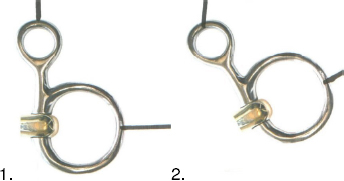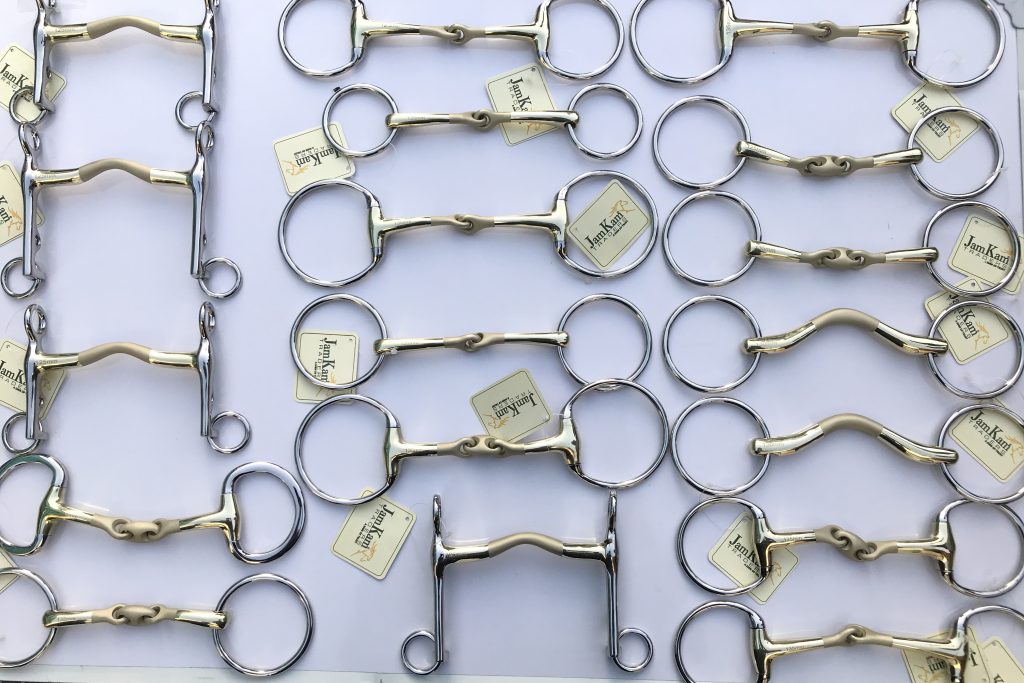Cheeks
The Action of the Loose Ring
The most popular – the loose ring has much more movement and play than a fixed butt or cheek. It discourages fixing, blocking and leaning and encourages mouthing. It allows the mouthpiece more movement so that it may follow the angle of the tongue because the angle of the poll and the horse’s overall outline changes through different work etc. A quality loose ring correctly fitted should not cause any nips or rubs.
The Action of the Eggbutt
This is a fixed cheek. Everything remains more still in the mouth and if a horse is lacking in the confidence to stretch into the contact, this may prove extremely beneficial.
The Action of the Baucher
When a contact is taken the upper arm is angled forwards causing the mouthpiece to lift – thereby suspending it in the mouth and reducing the pressure across the tongue and the bars – this is often beneficial for cases of over sensitivity. Any extension above the mouthpiece causes poll pressure – this in itself has a head lowering action. However, if the horse is going forward into a contact and active behind this will encourage a rounding action and help tremendously with the outline. This cheek is dressage legal as a Snaffle (on its own) or as a Bradoon used in conjunction with a Weymouth. The legal limit for the length of the Baucher/hanging cheek snaffle is 12 cm – this is from top to bottom – not just the upper arm.


- The Baucher at rest – the cheeks are always attached to the small ring and the reins to the one main bit ring.
- When a contact is taken the upper arms tilt forwards causing poll pressure and suspending the bit in the mouth – not only useful for promoting an outline but very beneficial for sensitive mouths as the pressure within the mouth is alleviated.
The Australian Cheeker


If you wish to lift the bit in the horse’s mouth a comfortable way of achieving this is by employing an Australian Cheeker. Obviously when the bit is suspended in the mouth, the pressure is reduced across the floor of the mouth, tongue etc. The Australian Cheeker is often seen on racehorses. It is generally made of rubber and it attaches to the headpiece, running down the centre of the face then divides in order to support the cheeks of the bit. The racehorses wear this in order to reduce the risk of the horse getting its tongue over the top of the mouthpiece.
I discovered the benefits of this many years ago with a Warmblood I had in for schooling. He was overactive in the mouth and constantly getting his tongue over the top of the bit. The benefits were immediate and it in time eradicated this long term tongue habit. It may be used in conjunction with any noseband but is not legal in a dressage test.
The Action of the Full Cheek
This reinforces the turning aids and providing the mouthpiece is the correct size (snug fit) will not allow the mouthpiece to slide back and forth across the tongue and bars thus reducing friction. If the upper cheek is fixed to the bridle cheekpiece with Fulmer keepers this will fix the mouthpiece in the mouth and also give some poll pressure. The full cheek is very useful for starting babies especially if you do not have access to a safe working environment such as an indoor or outdoor school. A lot of years ago before I got my outdoor I used to start babies in a big open field and it was often safer to use a Full Cheek as it will not allow the bit to pull through the mouth if a hazard is encountered. At this stage of their training, I would not generally fix it as we wish to encourage mouthing and acceptance.
The Action of the Half Cheek
The half cheek reinforces the turning aids and will not pull through the mouth – usually used in conjunction with fulmer keepers attaching the bit cheek to the bridle cheek piece. This fixes the mouthpiece and gives a little poll pressure.
The Action of the D Ring
This would fall under the category of a fixed cheek – it also helps with the turning. The racing D cheek is bigger in order to prohibit the bit rings from being pulled through the mouth. The D Ring is ideal for children or novice riders who are not always aware of the potential hazard of the full cheek. I have personally witnessed three accidents with the Full Cheek including once when a child dismounted and allowed her pony to rub his mouth against a brushing boot – part of the full cheek was caught under the ponies brushing boot near the fetlock (ankle) causing the pony to panic, snap his bridle and career off across a crowded show field. It can also very easily get caught in jumpers (sweaters), hay nets, etc.



